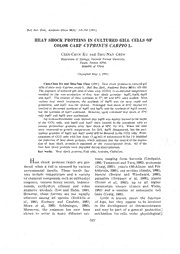
HEAT SHOCK PROTEINS IN CULTURED GILL CELLS OF COLOR CARP CYPRINUS CARPIO L. PDF
Preview HEAT SHOCK PROTEINS IN CULTURED GILL CELLS OF COLOR CARP CYPRINUS CARPIO L.
Bull. Inst. Zool., Academia Sinica 30(4): 319-330 (1991) HEAT SHOCK PROTEINS IN CULTURED GILL CELLS OF COLOR CARP CYPRINUS CARPIO L. CHEN-CHUN Ku and SHIU-NAN CHEN Department of Zoology, National Taiwan University, Taipei, Taiwan 10764, Republic of China (Accepted May 5, 1991) Chen-Chun Ku and Shiu-Nan Chen (1991) IIoat shock proteins in cultured gill cells of color carp Cyprinus carpio L. Bull. Inst. Zool., Academia Sinica 30(4): 319-330. The exposure of cultured gill cells of color carp (CCQ) to an elevated temperature resulted in the over-production of four heat shock .protei.ns: hsp87, hsp70, hsp33 and hsp27. The kinetics of their syntheses at 37°, 40° and 43°C were studied. With various heat shock treatments, the synthesis of hsp70 was the most rapid and prominent, and hsp27 was the slowest. Prolonged heat shock at 41°C beyond 6 h resulted in decreased syntheses of hsp87 and hsp70, and the synthesis of hsp33 ceased, but the synthesis of hsp27 continued. However, upon continued heat shock at 3rC only hsp87 and hsp70 were synthesized. An inmunofiuorescent stain showed that hsp70 was mainly located in the nuclei of the CCQ cells, and hsp33 and hsp27 were located in the cytoplasm with an intense perinuclear granules after heat shock at 40°C for 10 h. When the cells were recovered at growth temperature for 24 h, hsp70 disappeared, but the peri nuclear granules of hsp33 and hsp27 could still be detected in the CCQ cells. Prior treatment of CCQ cells with low doses (3 jig/ml) of actinomycin D for 1 h inhibited the induction of heat shock proteins, which indicates that the control of the expre.s.., sion of heat shock proteins is regulated at the transcriptionalleveJ; ~ All of the four heat shock proteins were degraded during electrophoresis~ Key words: Heat shock proteins, Fish cells, Arsenite, Cadmium. terns, ranging from bacteria (Lindquist, Heat shock proteins (hsps) are pro 1986; Yamamori and Yura, 1980), protozoas duced when a cell is stressed by various (Craig, 1985), yeasts (McAlister and Fin enviromental . Insults. These insult fac kelistein, 1980), sea urchins (Giudic 1989), J tors include temperature and a variety insects (Berger and Woodward, 1986), of chemical compounds such as sulfhydryl parasites (Newport et at., 1988), plants reagents, various heavy metals, iodoace (Nover et at., 1983), up to all higher tamide, sulfhydryl, ethanol and other mammalian tissues (Currie and White, aliphatic alcohols (Lee and Hahn, 1988). 1982) and a number of eukaryotic cell However, these-factors are not equally lines (Craig, 1985). effective among all species (Heikkila et Little is known about the function at., 1982; Kothary and Candido, 1982; of hsps, but they appear to be involved Misra et at., 1989; Schlesinger, 1986). in the development of thermotolerance Moreover., the response has now been and may be part of a general protective J shown to occur in many different sys- mechanism for cells under physiologica.IJ 319
